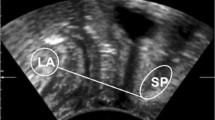Abstract
The biomechanical properties of the puborectalis muscle are likely to be important for pelvic organ support. However, neither elasticity nor its clinical correlate, muscle resting tone, have received much attention to date. We therefore conducted a prospective study to test a newly developed resting tone scale for validity and reproducibility. Ninety-eight patients underwent a physical examination including prolapse staging and palpation of the levator ani. They were also assessed by 4D translabial ultrasound for levator hiatal dimensions and prolapse assessment. Resting tone was negatively associated with anterior and posterior compartment prolapse. An independent test–retest series yielded a weighted kappa of 0.55 (CI 0.44–0.66), implying “moderate” repeatability. Resting tone of the puborectalis muscle can be determined by digital palpation. It is moderately repeatable and associated with pelvic organ prolapse. Palpation of resting tone may be a useful new tool for assessing women with pelvic floor dysfunction.


Similar content being viewed by others
Abbreviations
- ICS POP-Q:
-
International Continence Society Pelvic Organ Prolapse Quantification
- MOS:
-
Modified Oxford Scale
- ANOVA:
-
Analysis of variance
- PFMC:
-
Pelvic floor muscle contraction
References
Lanzarone V, Dietz H (2007) Three-dimensional ultrasound imaging of the levator hiatus in late pregnancy and associations with delivery outcomes. Aust NZ J Obstet Gynaecol 47:176–180
Dietz H (2007) Does delayed childbearing increase the risk of levator injury in labour? Aust NZ J Obstet Gynaecol 47:491–495
Dietz HP, Lanzarone V (2005) Levator trauma after vaginal delivery. Obstet Gynecol 106:707–712
Kearney R, Miller J, Ashton-Miller J, Delancey J (2006) Obstetric factors associated with levator ani muscle injury after vaginal birth. Obstet Gynecol 107:144–149
Dietz H, Simpson J (2008) Levator trauma is associated with pelvic organ prolapse. Br J Obstet Gynaecol 115:979–984
Dietz HP, Steensma AB (2006) The prevalence of major abnormalities of the levator ani in urogynaecological patients. BJOG: Int J Obstet Gynaecol 113:225–230
Dietz H, De Leon J, Shek K (2008) Ballooning of the levator hiatus. Ultrasound Obstet Gynecol 31(6):676–680
Dietz H (2007) Quantification of major morphological abnormalities of the levator ani. Ultrasound Obstet Gynecol 29:329–334
Dietz H, Shek K, Clarke B (2005) Biometry of the pubovisceral muscle and levator hiatus by three-dimensional pelvic floor ultrasound. Ultrasound Obstet Gynecol 25:580–585
Simons D, Mense S (1998) Understanding and measurement of muscle tone as related to clinical muscle pain. Pain 75:1–17
Laycock J (1992) Assessment and treatment of pelvic floor dysfunction. Ph.D thesis, University of Bradford, Bradford
Dietz HP, Jarvis SK, Vancaillie TG (2002) The assessment of levator muscle strength: a validation of three ultrasound techniques. Int Urogynecol J 13:156–159
Thompson JA, O’Sullivan PB, Briffa K, Neumann P, Court S (2005) Assessment of pelvic floor movement using transabdominal and transperineal ultrasound. Int Urogynecol J 16:285–292
Neumann P, Grimmer-Somers K, Gill V, Grant R (2007) Rater reliability of pelvic floor muscle strength. Aust NZ Continence J 13:8–14
Frawley H (2006) Reliability of pelvic floor muscle strength assessment using different test positions and tools. Neurourol Urodyn 25:236–242
Messelink B, Benson T, Berghmans B et al (2005) Standardization of terminology of pelvic floor muscle function and dysfunction: report from the Pelvic Floor Clinical Assessment Group of the International Continence Society. Neurourol Urodyn 24:374–380
Devreese AM, Staes F, De Weerdt W et al (2004) Clinical evaluation of pelvic floor muscle function in continent and incontinent women. Neurourol Urodyn 23:190–197
Thyer I, Shek C, Dietz HP (2007) Clinical validation of a new imaging method for assessing pelvic floor biomechanics. Ultrasound Obstet Gynecol 31:201–205
Oerno A, Dietz H (2007) Levator co-activation is a significant confounder of pelvic organ descent on Valsalva maneuver. Ultrasound Obstet Gynecol 30:346–350
Bump RC, Mattiasson A, Bo K et al (1996) The standardization of terminology of female pelvic organ prolapse and pelvic floor dysfunction. Am J Obstet Gynecol 175:10–17
Walsh E (1992) Muscles, masses and motion. Mac Keith, London, UK
Guaderrama N, Liu J, Nager C et al (2006) Evidence for the innervation of pelvic floor muscles by the pudendal nerve. Obstet Gynecol 106:774–781
Yang J, Yang S, Huang W (2006) Biometry of the pubovisceral muscle and levator hiatus in nulliparous Chinese women. Ultrsound Obstet Gynecol 26:710–716
Acknowledgements
This study was supported, in part, by the Betty Byrne Henderson Foundation, University of Queensland, Brisbane, Queensland, Australia, and by OZWAC (Australian Women and Children Research Foundation), Penrith, Australia.
Conflicts of interest
Hans Peter Dietz has received support in the form of loan equipment from ultrasound equipment manufacturers (GE Kretz, Toshiba, Bruel&Kjaer, and Phillips) and has received speakers’ honoraria from AMS, GE, and Astellas. He has acted as consultant for AMS and CCS.
Author information
Authors and Affiliations
Corresponding author
Rights and permissions
About this article
Cite this article
Dietz, H.P., Shek, K.L. The quantification of levator muscle resting tone by digital assessment. Int Urogynecol J 19, 1489–1493 (2008). https://doi.org/10.1007/s00192-008-0682-z
Received:
Accepted:
Published:
Issue Date:
DOI: https://doi.org/10.1007/s00192-008-0682-z




